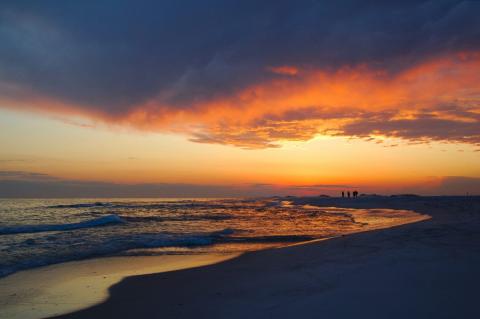The Open Ocean Trustee Implementation Group is planning restoration activities for the 2017-2020 planning years. We would like your input on restoration opportunities in the Open Ocean Restoration Area.
We will target restoration for wide-ranging and migratory species at important points during their life cycles and geographic ranges, including inland, coastal, and offshore areas. Open Ocean restoration types include:
- water column fish and invertebrates
- sea turtles
- birds
- marine mammals
- sturgeon, and
- mesophotic and deep benthic communities.
Some open ocean species are highly migratory so we anticipate some restoration outside of the Gulf of Mexico.
We are particularly interested in your input on living coastal and marine resource restoration actions that may be less likely to be implemented through restoration planning efforts of the state or region-wide restoration areas.
We would like to hear your project ideas and input on related monitoring and adaptive management activities to inform restoration planning, implementation, and evaluation for these restoration types. We encourage you to submit restoration ideas or revise previously-submitted ideas. We will consider previously-submitted projects relative to these specific restoration types and the process for project identification in the Trustees’ programmatic restoration plan. You can find previously-submitted projects in our database.
Additional information about these restoration types is available in Chapter 5 of the programmatic restoration plan. Please refer to guidance on our goals, restoration strategies, and implementation considerations for each of these restoration types. Project ideas will be evaluated for their ability to meet the goals of the programmatic restoration plan and the Oil Pollution Act.
This notice provides the range of potential restoration types that we might consider for restoration planning for the 2017-2020 planning years. We intend to plan for restoration actions to benefit all of the restoration types identified above and discussed further below through one or more draft restoration plans, and will coordinate with interested state trustees. We may choose to focus on a subset of these restoration types as planning progresses.
We will also consider projects that pertain to multiple restoration types or that will be implemented in phases. These submittals should include information about all project phases. We may also develop restoration projects for consideration.
We will consider project ideas submitted by May 15, 2017 in the development of one or more draft restoration plans. Projects submitted after the deadline will be considered in future planning.
We plan to hold a webinar to provide further information about our restoration planning process. We will provide the date and more information about the webinar soon.
Please contact us at OpenOcean.TIG@noaa.gov if you have any questions. We look forward to considering your restoration project ideas.
We are accepting project ideas with an initial focus on the following restoration types and approaches:
Restoration Type: Birds
We are prioritizing the following restoration approaches:
- Restore and conserve bird nesting and foraging habitat
- Establish or re-establish breeding colonies
- Prevent incidental bird mortality
We are also considering monitoring and adaptive management activities to address relevant data gaps to inform restoration.
Geography: Gulf of Mexico and outside the Gulf of Mexico
Restoration Type: Gulf Sturgeon
We are prioritizing restoration actions that will identify, restore, protect and provide access to spawning habitat, juvenile winter foraging habitat, and adult and subadult foraging habitat; as well as monitoring and adaptive management activities that are necessary to fill essential data gaps for restoration success.
Geography: Gulf of Mexico and associated watersheds
Restoration Type: Sea Turtles
We will prioritize the following restoration approaches:
- Reduce sea turtle bycatch in commercial fisheries through development and implementation of conservation measures
- Enhance sea turtle hatchling production and restore and conserve nesting beach habitat
- Reduce sea turtle bycatch in recreational fisheries (specifically pier and shore-based) through development and implementation of conservation measures
We are also considering monitoring and adaptive management activities to address relevant data gaps to inform restoration. These may include monitoring habitat use, species distribution, and threats; actions to standardize and integrate data; and actions to develop restoration planning, training, and management tools to reduce threats.
Geography: Gulf of Mexico and northwest Atlantic waters
Restoration Type: Marine Mammals
We will prioritize the following restoration approaches:
- Increase marine mammal survival through better understanding of causes of illness and death as well as early detection and intervention for anthropogenic and natural threats
- Measure noise to improve knowledge and reduce impacts of anthropogenic noise on marine mammals
- Reduce injury and mortality of marine mammals from vessel collisions
- Protect and conserve marine, coastal, estuarine, and riparian habitats
We are also considering monitoring and adaptive management activities to address relevant data gaps to inform restoration. These activities may include population characterization such as habitat utilization and exposure to stressors; development of tools and technology to support restoration planning, as well as the development of protocols, training and infrastructure to support standardized and integrated data collection and analysis.
Stocks/populations: Continental shelf and oceanic stocks in the Gulf of Mexico
Restoration Type: Fish and Water Column Invertebrates
We will prioritize actions that reduce bycatch and bycatch mortality (e.g., through mechanisms such as quota banks, barotrauma mitigation tools, circle hook distributions, shrimp trawl bycatch reduction devices). We may also prioritize monitoring and adaptive management activities to fill data gaps and information needs relevant to restoration, as well as outreach and education efforts.
Populations: Reef fish (e.g., snappers, groupers), highly migratory species other than sharks (e.g., tunas, billfish, swordfish), and coastal migratory pelagic species (e.g., mahi-mahi, cobia, mackerels)
Restoration Type: Mesophotic and Deep Benthic Communities
Restoration Approaches:
- Protect and manage mesophotic and deep benthic communities
- Place hard ground substrate and transplant coral
We are also considering monitoring and adaptive management activities to improve understanding of mesophotic and deep-sea communities to inform better management and ensure resiliency.
Geography: Northern Gulf of Mexico


